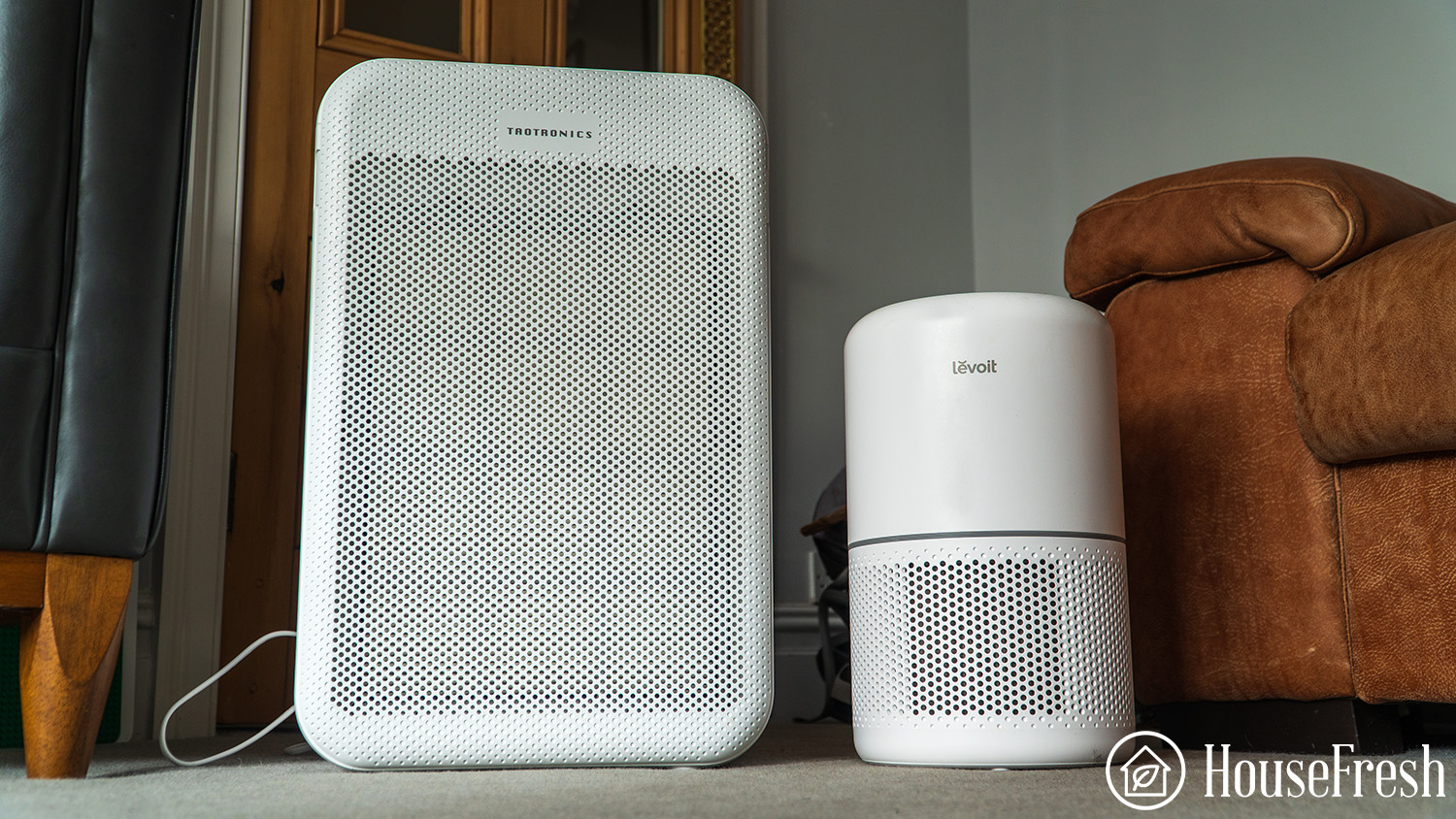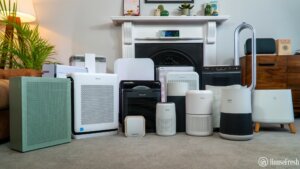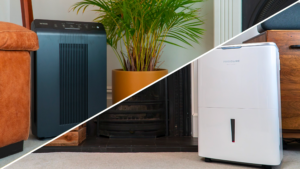If you’re considering buying an air purifier, you might wonder how safe they are to run in your home, especially if you have children or pets. You’ve come to the right place because we’ll be delving into everything in this article.
Firstly, we’ll look at how they work and the various filtration stages in high-quality purifiers. We’ll also explore the types of purifier you should avoid, namely ionizers and ozone generators and why these can be harmful to your health.
Finally, keep reading to discover some of the most common FAQs surrounding air purifiers, along with our answers.
How do air purifiers work?
As more of us become aware of the health hazards associated with indoor pollution, air purifiers have become increasingly popular. And with good reason: their many benefits include reducing airborne contaminants such as dust and pet dander and eliminating noxious odors like tobacco smoke.
Indeed, the EPA categorically states that these devices “can help to improve indoor air quality.”
Yet how purifiers work isn’t generally discussed quite as much, so let’s dive in. The first thing to understand about a decent purifier are the various stages of filtration:
Pre-filter
As its name suggests, this is the first step in the purification process. The pre-filter is designed to capture large particles like hair, dust and pet dander.
Carbon filter
VOCs (volatile organic compounds) are found in many household items, from furniture to nail polish. Breathing in VOCs can harm health, and carbon filtration is designed to eliminate such pollutants. The carbon filter is also great for removing household odors, from tobacco smoke to cooking.
HEPA filter
The most crucial element of filtration, the HEPA filter can capture 99.97% of airborne contaminants as tiny as 0.3 microns, including pet dander, pollen and mold. This is especially important if you suffer from allergies or health conditions like asthma.
Most of these stages are found in mechanical air purifiers, which are not only regarded as the most effective but also the safest type of purifier.
Rest assured, then, that all the above filtration phases are completely safe.
However, there are two types of air purifiers that we strongly recommend you steer clear of…
Ionizers and ozone generators are not safe
The first type of purifier to avoid is called an ionizer. Unlike mechanical devices, these are electronic and work by producing a static charge to release negative ions. The ions then become attracted to various things in your home and stick to furniture, walls, draperies and even people.
While some of the benefits of ionizers include removing small particles from indoor air, for example, in tobacco smoke, the disadvantages are far greater. The most worrying drawbacks are that they can produce nitrogen oxide and ozone as by-products, both of which are harmful to health.
Ozone can seriously affect people’s lungs and is of particular concern. According to the EPA, these kinds of purifiers can generate ozone concentrations that are “significantly above levels thought harmful to human health.”
With this in mind, it seems hard to believe that there are also purifiers which are literally called ozone generators, but, yes, it’s true. Again utilizing electricity, these devices directly produce ozone with the intention that it will attach itself to the pollutants in your home and kill them.
Although ozone generators can be effective for professional cleaning or eliminating smoke odors from fire-damaged properties, they are NOT suitable for personal use. Ozone isn’t only seriously bad for your health; it can also damage your home appliances and building materials.
So if you’re seriously thinking about buying an air purifier, be sure to keep all this in mind. The team at HouseFresh definitely do not endorse either of these models.
Frequently asked questions about air purifier safety
Yes. Most purifiers are actually designed to run 24/7, so keeping it switched on every night and while you sleep is absolutely fine. The longer you keep your device running, the cleaner your indoor air will be as contaminants and pollutants are continually being removed. Using it in your bedroom can help you breathe more easily, which will promote better sleep.
If you’re concerned about the noise levels when running a purifier at night, most models have various settings so you can switch it to the lowest one while resting or sleeping. For peace of mind, however, check the product information to find out how much noise each purifier emit
Absolutely. Indoor pollution may harm babies and children so using an air purifier can reduce the risks of kids developing allergies, asthma and lung conditions. Equally, various studies have shown that contaminated indoor air can seriously impact the respiratory systems of cats and dogs. Using an air purifier around pets, therefore, improves their health, too.
However, there are a few things to keep in mind. Firstly and as we’ve already covered, never run a purifier that uses ionization or generates ozone. Similarly, as many purifiers plug into an outlet, curious kids may be at risk of electrocution, whereas pets can become trapped by the cord. Be sure to keep your device out of reach to avoid such incidents.
It is completely healthy. For people who suffer from allergies such as pollen, pet dander, or asthma, air purifiers can significantly help improve symptoms. Likewise, many of the best models can remove particles that contain viruses, thus decreasing the chances of you and your family getting sick.
However, it’s important to choose the right device. This means opting for a mechanical unit with the various filtration stages and — we’ll repeat it — steering well clear of ionizers/ozone generators.
Also, note that filters like HEPA and activated carbon need to be replaced as they can become clogged with dust and debris. It’s generally advised to do this every 6-12 months or more frequently if they become filthy.
No they don’t; it may just feel as if the air is drier. The purpose of an air purifier is to clean and purify the air, rather than dry it out. Devices such as dehumidifiers, on the other hand, are specifically designed to reduce moisture levels and thereby increase dryness.
There can be a couple of reasons why your air might feel drier when using a purifier. The first is that when purifiers circulate air, this can have much the same effect as using a fan. The air can feel dry merely because it’s moving around.
Secondly, if the air itself is quite cool, this may seem as if it’s drier, yet this isn’t the case. Air purifiers are simply unable to alter the humidity in your home.
As we’ve already discussed, it’s perfectly safe to keep your purifier constantly running to maximize its effectiveness and ensure the air you breathe is clean and healthy.
But what if you’re concerned about electricity costs or simply don’t want to keep it running all the time? Well, you can keep it on while you’re at home and turn it off when you leave the house. Or you could try running it for 12 hours daily and then switch the unit off at night.
If you suffer from seasonal allergies, you may need to keep it on all the time during spring and summer. Likewise, if your home has been affected by wildfire smoke, you should run the device continuously to remove harmful particles.
Final thoughts
Breathing clean, healthy air is vital and using an air purifier is one of the most effective ways you can combat indoor air pollution. If you’re concerned about the safety of these devices, don’t worry because standard purifiers are completely safe to use. You can even run them throughout the day and night.
However, two types of purifier that are definitely not safe to use are ozone generators and ionizers. Whether directly or indirectly, these devices produce ozone, which is harmful to your health and can irritate the lungs. As long as you steer clear of these models, using an air purifier with effective filtration methods will help improve your indoor air.
SOURCES
- Allen, P. (2022). HouseFresh. How Do Air Purifiers Work? housefresh.com
- Booth, D. (2022). HouseFresh. Do Air Purifiers Make the Air Dry? housefresh.com
- Booth, V. (2021). Home Air Guides. How Often You Should Really Be Running an Air Purifier. homeairguides.com
- Cookson, M. (2022). HouseFresh. What Are the Types of Air Cleaning Technology Used in Air Purifiers? housefresh.com
- Cherney, K and Lamoreux, K. (2023). Healthline. Do Air Purifiers Actually Work? healthline.com
- Environmental Protection Agency. (2022). Air Cleaners and Air Filters in the Home. epa.gov
- Environmental Protection Agency. (2022). What are ionizers and other ozone generating air cleaners? epa.gov
- Environmental Protection Agency. (2021). Indoor Air Quality. epa.gov
- Jones, L. (2021). Live Science. Are air purifiers safe for pets? livescience.com
- King, H. (2021). Molekule. Should you sleep with an air purifier on? molekule.com
- Lacoma, T. (2022). Digital Trends. How long do I run my air purifier? digitaltrends.com
- Mousseau, J. (2021). WebMD. What to Know About Air Purifiers. webmd.com
- Purifan. (2019). Is Your Air Purifier Safe? purifan.com
- WebMD. (2021). Are Air Purifiers Safe for Babies? webmd.com






